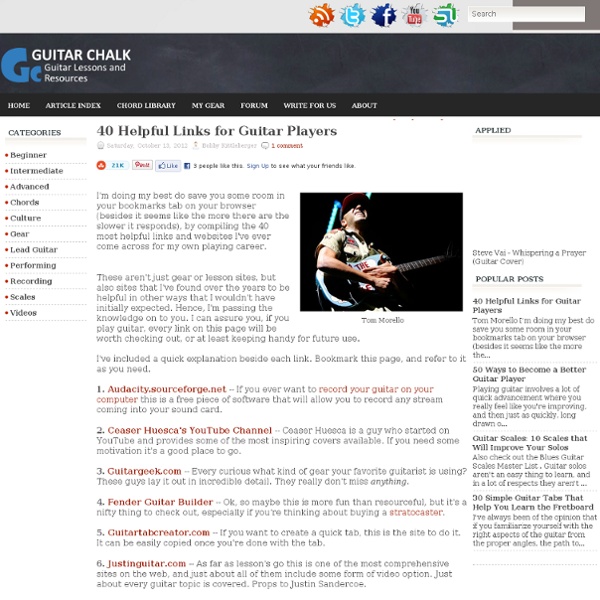40 Helpful Links for Guitar Players

Guitar Technique and Warm Up Exercises with Tabs
Here are some technique and warm up exercises that can help you to gain fluency, speed and accuracy on the guitar neck. It's a good idea to do some of these exercises every day. Don't do them too long at a time, it's better to exercise regularly (daily) for a short time. You gain the most out of these exercises if you use a metronome. Start slow and built up the speed. Just to make sure we understand eachother in terms of finger naming (warning: the numbers on the tabs below are not finger numbers, but fret numbers): Click Here To Download Your Free Jazz Guitar eBook Warm Up Exercises This first exercise helps to develop your fluency, speed and left hand-right hand coordination. The next exercise trains your individual fingers. String Skipping Exercises The following set of exercises train your picking abilities. This is one of bass player John Patitucci (if I remember it well). The next exercise uses the G major scale. Intervalic Guitar Scales In thirds: In fourths: In fifths: In sixths:
Know Every Note on the Guitar in 9 Days
Knowing every note on the guitar is a challenge unique to the instrument. A saxophone has only one way to finger each note, while a guitar usually has a few different strings and four fingers to choose from. String a few notes together and the permutations of how to play them will wreck your brain. Pianists have a similar problem with ten available digits, but you can memorize the notes on a keyboard in a matter of minutes; the same pattern of white and black keys repeats every octave. The challenge with navigating the guitar fretboard is its two-dimensional layout. Why Know the Whole Fretboard? If you don’t know every single note on the guitar cold, without hesitation, then I highly recommend taking a little time to get that under your belt. The primary advantage to knowing every note on the fretboard is in creation. If you haven’t started playing yet, come back to this after you’ve learned some music. Day 1: Open Strings Know your open strings like you know your alphabet. Conclusion
20 Tips On Songwriting
Every songwriter goes through times when the inspiration just seems to dry up, and the perspiration doesn't seem to be working. Debbie Poyser offers some guidance. Songwriting is a skill that is rarely taught: musicians more often than not tend to write instinctively, absorbing their ideas about form and structure from the music that's around them, and relying on inspiration for their melodic and lyrical direction. 1. 2. 3. 4. 5. 6. 7. 8. 9. 10. 11. 12. 13. 14. 15. 16. 17. 18. 19. 20.
Electronic Music Theory: How to Quickly Write Better Chord Progressions w/ Pat Cupo
A lot of students have asked me for tips and tricks to writing better chord progressions. By that time they had already learned about building Major and Minor chords, but when it came to a chord progression – a series of chords occurring in time – they were a bit stuck. If you’re ever in the same position, then feel free to use these simple guidelines to help you quickly write chord progressions. Follow them carefully and strictly at first and over time it’ll start to come naturally to you. 1) Use only Major or Minor chords. Just keep things simple. C Major [audio: Major Chord C Minor [audio: Minor Chord 2) Begin and end with the same chord The thing about music is that it’s like a game. [audio: Minor Chord So what chord am I going to end with? 3) Move freely among diatonic chords The word Diatonic means “from the tonic”. What’s Included:
Deezer
100 Ways to Discover and Enjoy Music
UPDATE 12/10/13: We’ve released a follow-up to this post with 100 More Ways to Discover and Enjoy Music. Prepare yourself for another dose of Monday roundup madness! It’s time for another crazily comprehensive, yet carefully curated, look at an entire industry–the music industry to be specific. This if the first in a two-part series on the music industry which will conclude next week. You might also like: exfm – See what’s trending. There’s more to this article!
Related:
Related:



